Art of the Waterfall
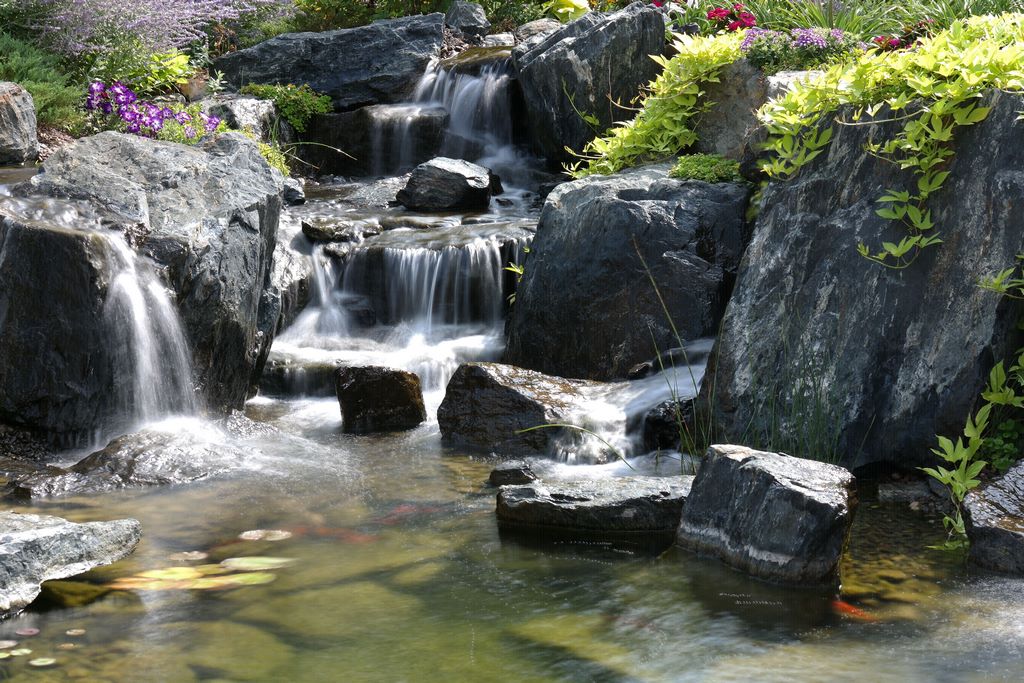

No matter whether it’s a pond, stream or swimming pool, waterfalls are an appealing part of the composition — which is why Larry Carnes includes them in most of his projects. Here, he shares some approaches to making these features both naturalistic and completely mesmerizing.
Waterfalls can be beautiful, and from a design standpoint, extremely useful. They add verticality to otherwise horizontal water surfaces, animating the scene with movement and sound, creating eye-grabbing focal points and, when done well, a waterfall add a natural element that looks as if it was there first and humans came along and built a home to be close to it.
Waterfalls have many personalities. They can be tall and bold, even thunderous; or gentle and subtle, with just a small flow. They can be diffused with divided flows spread out over multiple small vertical transitions or more concentrated to create a more dramatic effect. Each one is different, just as every project and client are different.
As one of nature’s truly fundamental “water features,” the way we create waterfalls is really only limited by imagination — that and space and budget. But no matter the character, size, complexity, or lack thereof, all waterfalls can have a positive impact on those who spend time near them.
When I think of waterfalls, I’m visualizing those made by nature or made to appear natural. There are architectural water features that do loosely qualify as waterfalls in the form of water walls, scuppers sheer descent falls, or even rain curtains. Those features can also add beauty and interest to the setting, but to my mind, it’s the naturalistic waterfalls that are both the most beautiful and the most challenging.
MUSIC MAKING
One of my favorite aspects of waterfalls is the sound they make or music, some might say. It comes as a pleasant surprise to many of my clients how much they appreciate hearing the sound of moving water, and it’s often something they discover after the fact. Sometimes, they don’t even have to see where it’s coming from, they simply enjoy the relaxing psychological effect of the sounds wafting through air. There are those who say they enjoy the sound as much or more than any other aspect of their water feature.
In some situations, clients are looking to mask traffic noise or other aural intrusions; in others they just want the tranquil effect. Either way, it’s important to realize that when you build a waterfall, you have to consider the sound it makes and how it will function in the environment.
Watershapers have a surprising amount of control over the sound water makes.
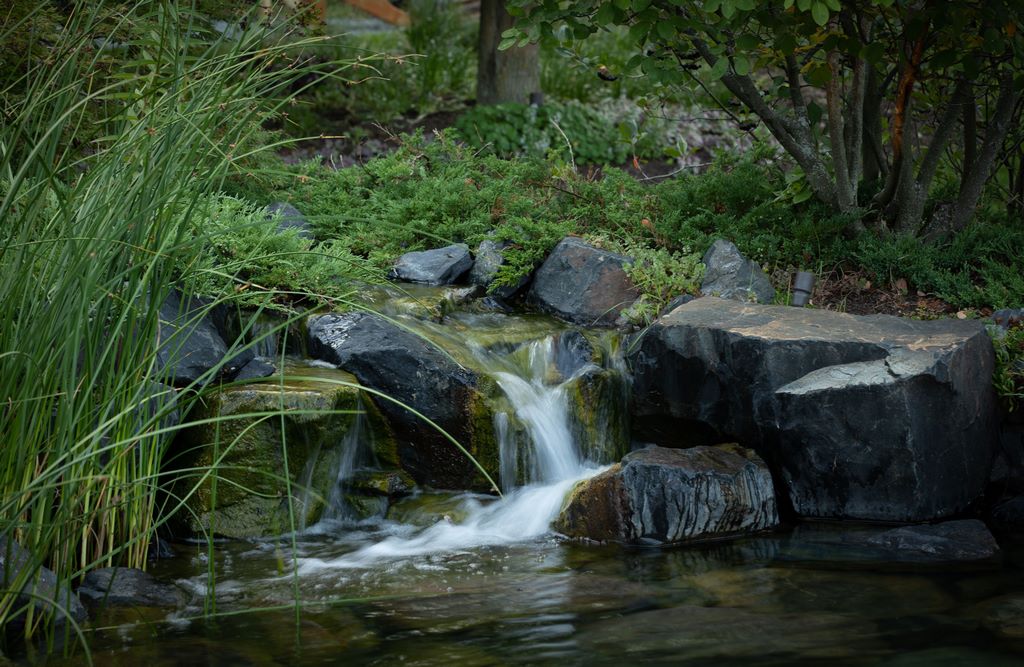 Consider volume: Too much sound can overwhelm a small yard and become obnoxious, while too small a sound in a large area won’t have any effect at all. You must strike a balance. Generally speaking, the more water that’s flowing, and the farther it falls, the more sound it makes; but there’s much more to it than just relative loudness.
Consider volume: Too much sound can overwhelm a small yard and become obnoxious, while too small a sound in a large area won’t have any effect at all. You must strike a balance. Generally speaking, the more water that’s flowing, and the farther it falls, the more sound it makes; but there’s much more to it than just relative loudness.
There’s also tone and texture of the sound. Most people don’t realize how complex the sounds of moving water can be. The combination of volume and flow rate of the water, married with the way the waterfall rocks are configured into cascades or weirs, the texture of the rocks, the way falls are divided and unified and the depth of the water, all create different types of sound. The more complex the waterfall structure, the more varied the sounds and the more choices you have in “tuning” it.
There are tones that can become an inadvertent problem, such as how the fine rain-like sound of uniform drops sheeting into the water can generate a “white noise” that can actually almost cancel out, or mask, the sound of the human voice. Or, if you have a singular stream of water falling directly into an otherwise quiet pond, it can sound like someone urinating.
I’ve played with sound a lot, learning to manipulate the low tones, mid-tones and high tones, paying close attention to the sounds made as the water dances over the rocks. The differences between the sound of water flowing over smooth stones, splashing its way down more jagged formations, or the change in sound when you narrow and speed up the flow verses when you spread it out or slow it down.
Bottom line; do not turn a deaf ear to the music you can make when you pay attention to it.
THE NATURAL LOOK
In the broadest sense, manmade waterfalls are either architectural or naturalistic — design modalities that are entirely different disciplines. Both can be great, but when the two get confused that’s when you run into trouble.
As a starting point, achieving a natural look means avoiding many of the common missteps that disrupt the illusion that nature made the scene and not humans. In nature, for example, water almost never erupts from the top of a pile of rocks. Yet, I can’t count the number of times we’ve seen piles of real or artificial rock plopped in the middle of a landscape with water magically emerging from the highest point.
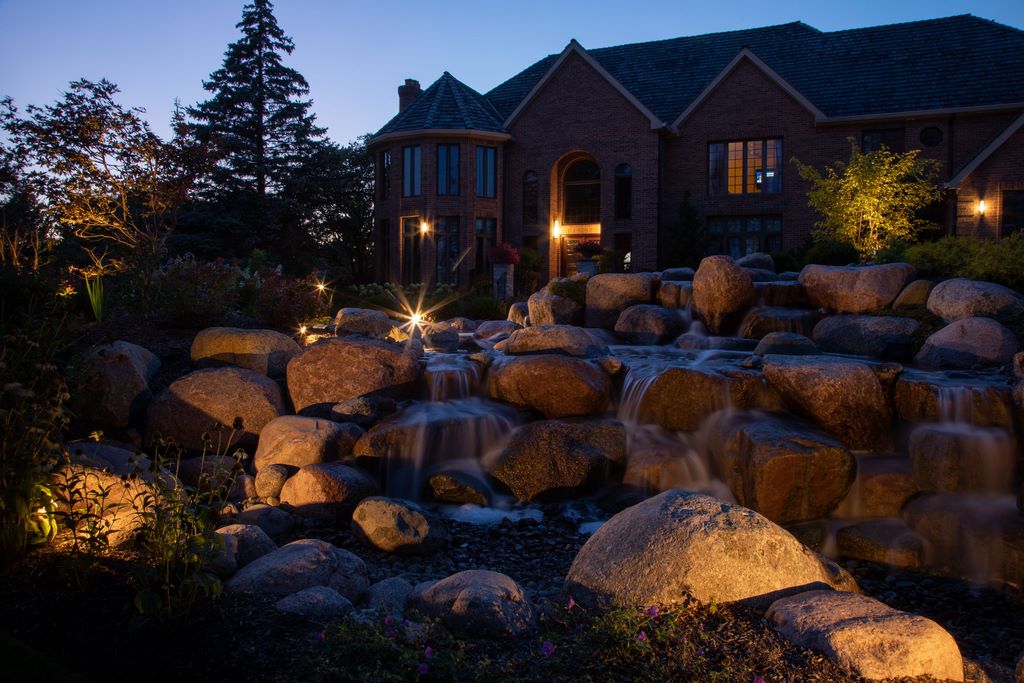 In nature, the source of the water is almost always unseen, flowing into the landscape from a higher elevation. Which is why wherever possible, we find ways to conceal the water’s origin. No one wants to see water following out a pipe or a culvert. It’s much better to have the water entering the scene from behind a rock, or invisible welling up in a bog or small pond area.
In nature, the source of the water is almost always unseen, flowing into the landscape from a higher elevation. Which is why wherever possible, we find ways to conceal the water’s origin. No one wants to see water following out a pipe or a culvert. It’s much better to have the water entering the scene from behind a rock, or invisible welling up in a bog or small pond area.
And, nothing says you have to add all the water at the top of the system. We often plumb hidden injection points at different strategic locations downstream of the headwaters. We’ll often add to the volume just ahead of a set of falls or where we want to create a ponding area. We might be doubling or even tripling the volume of water, but you’d never know by looking at it.
The rock structures over which the water flows should always reference the surrounding landscape. When the stone material and plantings that comprise a waterfall’s structure don’t fuse into the surroundings, it looks like someone came along and just dumped it there for the purpose of building a water feature. The same is true of rock material used to surround a pond or stream; in nature moving water exposes the landscape and geological features, so you expect to randomly see the same material in the surrounding areas.
Regarding edge treatments, at all costs avoid the “riprap” look. Uniform size stone material in uniform placement always looks manmade. Unless you’re going for the drainage-ditch effect, in a waterfall or anything else, just don’t do it.
The same is true of flat and straight knife-edge weirs, they almost always look manmade. I’ve seen countless “grotto” structures where the builder plops a big flat rock on top to create a curtain over the open space. I’m all for figuring out ways to see waterfalls from the back side, and it can be done and still look natural, but when you use a long, flat and straight weir, it just looks completely fake.
We always vary the way water flows over the edges of the falls, observing things like the way natural waterfalls cut channels into rock faces, the way water splits and divides into side flows around prominent rocks, and then rejoins or speeds up over cascades and then slows down in small ponding areas that form within the falls.
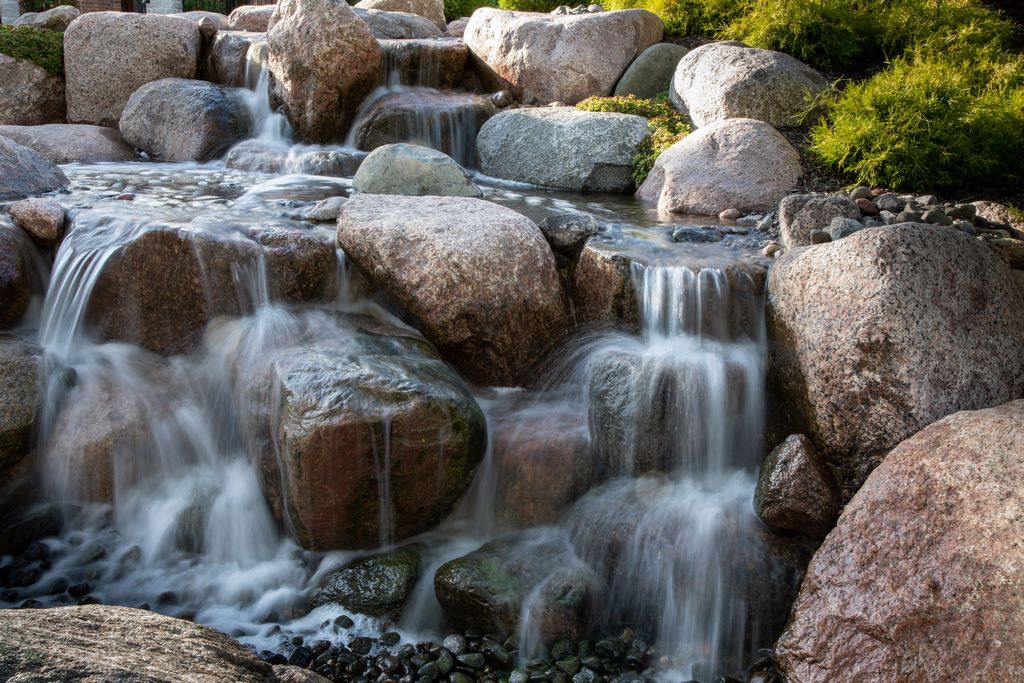 Many of our clients have no idea what they can have and they’re often blown away when they see images of our past work. Once they do embrace the possibilities, they can get pretty excited and start visualizing on their own.
Many of our clients have no idea what they can have and they’re often blown away when they see images of our past work. Once they do embrace the possibilities, they can get pretty excited and start visualizing on their own.
In one of our more recent projects, we had a large set of falls, but then the client wanted more, so we came back and divided the flow into a set of side falls and they loved it. A couple years later, they decided they wanted even more so we extended a retaining wall and liner, then built out three new falls. Now it’s a beautifully intricate set of falls that spread out over a wide area.
All of our waterfalls, as well as streams and ponds, include generous plantings. In nature you’re going to see all sorts of plant life in and around water, so we do the same thing by including shelves and planting pockets. Greenery draping over rocks and all of the various emergent and terrestrial plants that populate the water’s edge, they all work to soften and balance the rock formations.
Through it all, there’s no short cut to re-appropriating nature, you have to spend time studying the way natural streams and waterfalls work. It doesn’t hurt that doing so usually means going somewhere beautiful and paying attention to what you see. There are recognizable patterns, but infinite variations on the way water interacts with earth, stone and plants. It’s the best possible kind of homework.
INTO SPACE
It’s impossible to design a naturalistic waterfall the way you would an architectural one. Because you’re working with natural stone material, there’s no way to precisely diagram, dimension or detail the exact finished product. Instead, the planning is more along the lines of setting the stage for what amounts to an almost improvisational performance that will unfold when you actually lower the rocks into place.
When we approach designing a waterfall, we begin by figuring out where it will go, which can involve a variety of issues such as the primary focal points, where the clients want the waterfeature in relation to the home, where and how they are going to view it, whether it’s in plain view, or tucked away where the sound leads to you to a destination.
Waterfalls are usually part of some kind of stream/pond composition, so where you put them is always in context of the overall layout, starting with elevation changes and slopes. Depending on the situation, we’ll cut shelves into the slope where we know we’ll be placing the falls. For large vertical transitions, we’ll install retaining walls and back fill them, all of which is covered by a liner system. When the rocks are in place, the substructure and liner are completely hidden from view.
 We recently completed a project in the Atlanta area having 12 feet of grade change over a relatively short distance. That meant we could have all kinds of fun creating a complex and dramatic set of falls.
We recently completed a project in the Atlanta area having 12 feet of grade change over a relatively short distance. That meant we could have all kinds of fun creating a complex and dramatic set of falls.
We started out wanting to cut back into the slope to make it look like the water had carved its own channel; but the client wanted it to be more prominently displayed. To accomplish that we built a retaining wall to pull the slope forward, back filled, feathered into the landscape with spoils, and then notched back into that slope to make it look natural.
As mentioned above, we like to add water at different points in the system, a big part of the preliminary design and installation is figuring out exactly where you want those point to be, which means thinking ahead about the falls they’ll be feeding. Distributing grade changes and the flow supports layering the views with series of falls and ponding areas.
IMPROVISATIONAL ART
Some people who build naturalistic watershapes will say that the rocks talk to them when they’re working on, or composing, rock placement. There’s no easy way to explain it, when the rocks are delivered, you immediately start puzzling together in your mind how and where they’ll be placed.
Material selection is key to every project and we go to great lengths to find stones that fit into the design scheme, in terms of size and aesthetics. Surface pieces that reveal the effects of erosion, oxidation, as well as lichen and moss, are great for places where the stone is highly visible. The more interesting the rock, the greater chance it will be cast in a staring role. Less descript boulders can be used as more structural elements.
Patterns and texture often come into play. For example, when you work with sedimentary stone that has stratifications, you want to line up the patterns, so it looks very much like a real geological formation. If you don’t pay attention that kind of that detail, it won’t look right.
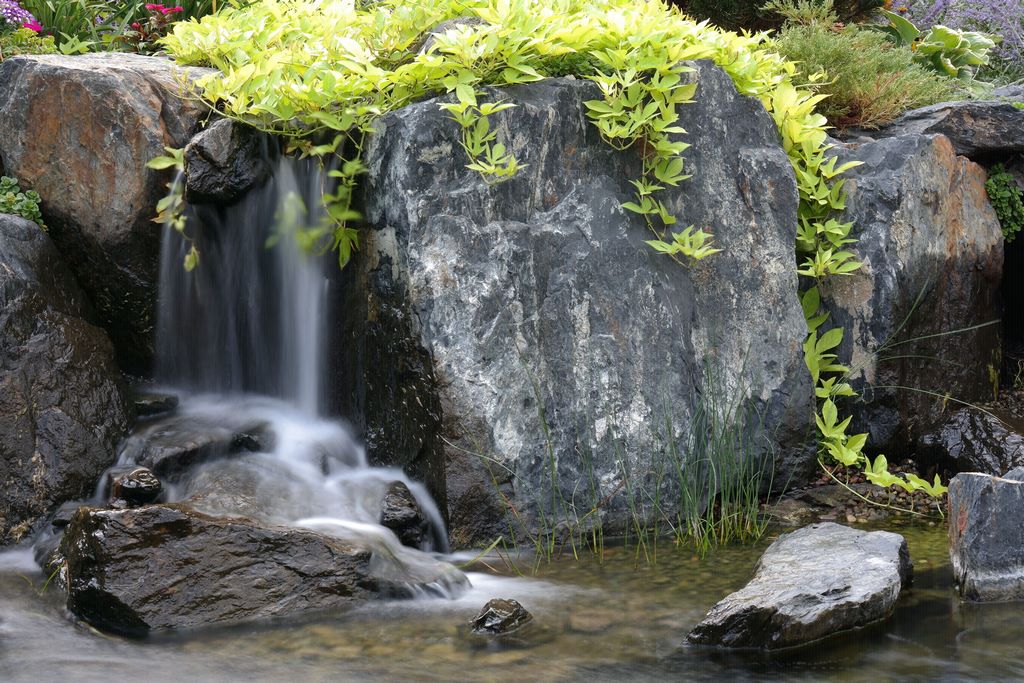 The size of the material can work the same way. In the Atlanta project mentioned previously, we were having the rocks delivered by the truckload. One of the loads showed up with stone that was the same material, but it was broken into smaller pieces, so, we had to improvise.
The size of the material can work the same way. In the Atlanta project mentioned previously, we were having the rocks delivered by the truckload. One of the loads showed up with stone that was the same material, but it was broken into smaller pieces, so, we had to improvise.
We built up a section of the waterfall on one side where it looks like the material is softer, it’s more weathered, with more intricate channels, but it looks similar to the way nature might distribute smaller material that’s being eroded more quickly. We may have been improvising, but the result looks great.
It helps to have a mix of flat pieces for horizontal planes and more vertical boulders for vertical transitions. In some projects, we’re working with rock material that’s fractured with sharp edges, flat planes and crisp lines. In other projects, we’re working with smooth rounded material you find in glacial deposits, which are very common here in the Chicago area.
The features of the rock will largely dictate the “personality” of the waterfall. Sharp, craggy rocks will cut up the water flow, giving you one type of look where the water is almost fighting its way over the stone, while rocks that have been smoothed by rivers or glaciers will create a much gentler personality as the water cuddles the smooth contours.
While there is an improvisational aspect to the process, there’s also a lot of heavy lifting involved. Yes, it’s an artistic process, but you never get too far away from the labor-intensive aspect of the work.
Rock placement should always be a deliberate and careful process. Rigging each big rock is a little different and safety is always a primary concern. We place our rocks so that they are mostly held in place by gravity, but we’re also backfilling with concrete to further lock everything in place. Only rarely do we “pin” the stone in place with steel dowels.
HUMAN TOUCH
Ultimately, waterfalls exist to create an experience. Giving people easy ways to come close to water is a big component of successful installation. That’s why we do a lot with stepping stones across the water just above or below a waterfall, which can bring you within inches of the falls.
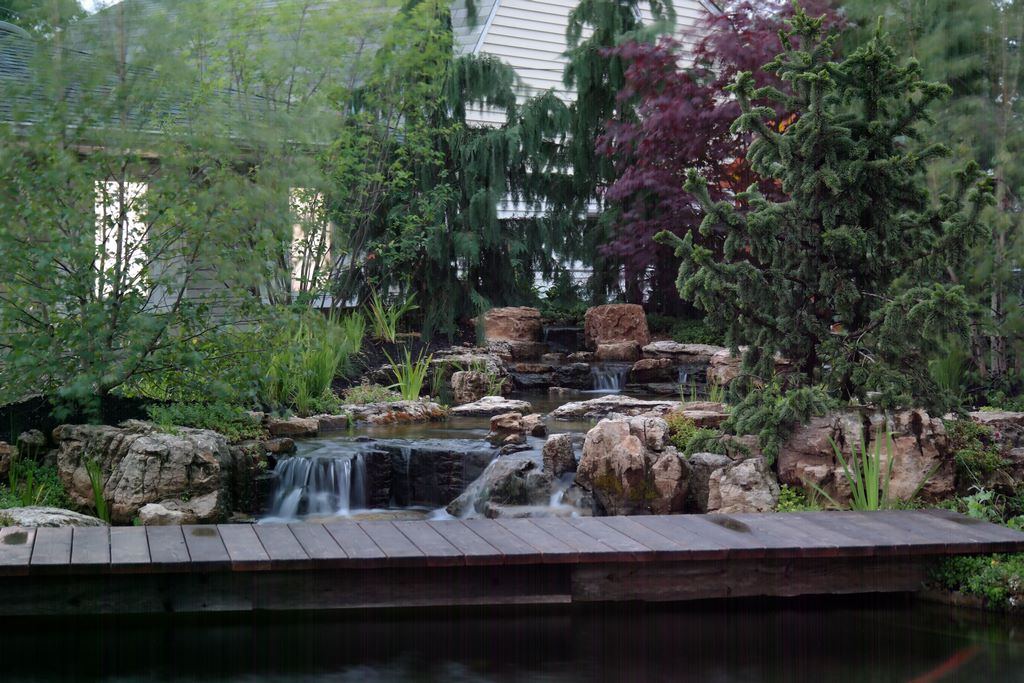 We install flat rocks extending from the shore into the water bringing one close to the falls and able to look down into the depths of the pond. For many projects, we’re installing bridges over parts of the stream close to or over a waterfall, or a deck that serves as a viewing platform for nearby falls.
We install flat rocks extending from the shore into the water bringing one close to the falls and able to look down into the depths of the pond. For many projects, we’re installing bridges over parts of the stream close to or over a waterfall, or a deck that serves as a viewing platform for nearby falls.
Lighting waterfalls further enhances the homeowner experience because they can enjoy the scene after the sun goes down, often when they come home from work or are entertaining during the evening. The lighting of moving water is an entire subject unto itself, considering the myriad ways you can highlight parts of the scene to animate the water with light.
Consumers may or may not think about their waterfalls from such a nuanced perspective, but the sight and sound of beautifully composed falling water will always have a positive emotional impact. Fact is, waterfalls make people happy and that’s what the art is really all about.
Larry Carnes is owner of Reflection Water Gardens in West Dundee, Ill. He began is career as a student of art and developed an interest in landscaping. He worked for several companies, gaining knowledge in tree care, patio design and installation, and landscape architecture. Now a devoted student of naturalistic watershape design, Carnes strives to create ponds and water features that qualify as art.









